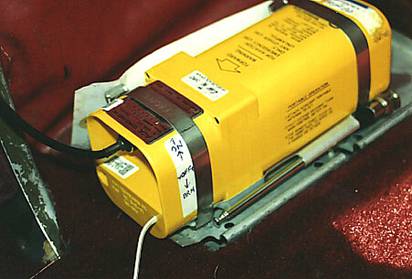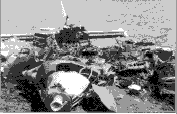Let's Take the SAR... out of "garbage"!

Have you removed the batteries?
"What's that?" you say " There's no SAR in garbage, regardless of what language you're spelling." That may be true. But a month or so ago, there were numerous SAR techs and other SAR-related people rummaging around in a Canadian garbage dump, much to the consternation of the resident Jonathan Live-it-up seagulls, who are not accustomed to fighting with SAR techs for their share of the — ahem — spoils.
What on earth brought them there? Initially, it was something above the earth. COSPAS-SARSAT to be exact. These alert sentries detected an ELT signal. Using suitable linkage, the SAR system came up with a fairly large circle in which the ELT could be located. A SAR aircraft initially aimed at the circle, then, as it flew closer to the site, homed to the beacon. The spotters squinted through their various windows, looking for the scattered remains of an aircraft.
Despite their squintiest gazes, there was no sign of an aircraft, but there was lots of aerial activity. Flocks of seagulls, buzzards and pterodactyls wheeled soared and swung in the air currents wafting heavenward from the local garbage dump.
Could the aircraft have gone in like a dart and have been covered up with garbage? Perhaps, but there were no reports of missing aircraft in the local area. Besides, as garbage dumps go, this one was reasonable tidy. It did not look as though it had recently been re-arranged to accommodate a crashed aircraft.
But there was no doubt about it. The ELT signal was coming from the garbage dump. What to do? Find it. Thus it was that a flock of folks went rummaging through a garbage dump looking for a transmitting ELT.
Eventually, they found it. Down at about the 3-ft level, searchers came upon a perfectly serviceable ELT, squawking its little electronic heart out. Someone had discarded it with the batteries still inside, and the function switch in the ON position. When the bulldozer operator came along to spread out fresh treats for the gulls, the blade evidently gave the ELT a sharp enough rap to set it singing.
SAR was in the seagull-herding business on the West Coast, as well. Several aircraft, Vancouver Area Control Centre and the satellites all reported an ELT close to Vancouver Harbour. Again, there were no reports of missing aircraft, and the ATS people running the harbour traffic still had an equal number of takeoffs and landings. Even if they hadn't, any ELT that had slipped below the waters wouldn't be disturbing all those folks on the surface. A SAR Labrador was summoned. Again, the spotters had their eyeballs spring-loaded to the pop-out position. When they got close to the "on-top" position they looked down a saw a ship. The signal ceased before they could confirm its origin. They went home.
A few hours later, the Coast Guard reported hearing an intermittent ELT signal. Industry Canada was called in. After following the bouncing signal around the Harbour, they were led to the same ship which had attracted the Lab. Being a container ship, it was full of, what else?, containers. Inside one of the containers was a neatly packaged helicopter headed to an exotic foreign destination.
Inside the helicopter was — you guessed it — an ELT with its function switch in the ARMED position. Apparently the crane operator didn't set the helicopter container on the deck with the same delicacy that a pilot might have used. The ELT thought that it had crashed. Despite all the bits of ship that were in the way, the signal still made it out into the ether with sufficient strength to keep SAR excited for the best part of eight hours.
Not many people are discarding ELTs right now. The ones that they have are adequate; they'll do until the regulations change, some time around the year 2000. But as that time comes closer, more people will buy new ELTs and discard their old ELTs. If they do it the way that the garbage dumper did it, they could destroy the SAR alerting system for a lengthy period.
Never, ever, throw away an ELT with a battery in it. Never, ever, throw away an ELT with its function switch ARMED or ON; battery or no battery. The transmission from an undamaged ELT in a garbage dump can mask a transmission from a damaged ELT trying to alert SAR to an emergency.
Similarly, if you're shipping an aircraft by ship, train, truck or air, ensure that the ELT function switch is OFF. If possible, remove the batteries. Placard the aircraft when you do this, so that the pilot at the other end of the voyage knows that the ELT — and the batteries — must be re-installed before flight.
The ELT-SARSAT-SAR-CASARA team works well to provide SAR alerting, pinpointing and rescue. Around the world, the team has been instrumental in locating and rescuing 1624 aviators in 755 aviation distresses since 1982.
Good as they are, they need your help. You buy, use, maintain and eventually discard the alerting part of the system. When doing so, please use the same high standards of airmanship that mark your other aviation activities.
Help keep SAR out of garbage dumps. It'll help prevent neurotic seagulls.
Originally Published: ASL 4/1997
Original Article: Let's Take the SAR...out of "garbage"!
Total Electrical Failure... Using Your Resources

The ferry pilot was making a night transit from Reykjavik, Iceland, to Florida via St. John's, Newfoundland, in a Britten-Norman Islander.
Sometime after departing Iceland, she noticed that the right alternator had failed, but she elected to continue to St. John's.
About 160 mi. from destination, still over the cold grey North Atlantic, she had a complete electrical failure, leaving her without light, radios or navigation aids. However, she was not without resources: using a portable global positioning system and a flashlight, she was able to continue to St. John's, where, with the aid of a portable radio, she re-established communications.
The weather was 300 ft. overcast with 2 mi. visibility and, without electrical power, she was unable to fly an instrument approach. Undaunted, air traffic control provided the pilot with vectors for a successful emergency surveillance approach.
As the aircraft touched down, one engine quit. The pilot shut down the other engine after the landing roll.
After the aircraft was towed to the ramp, she called the tower controller to thank her for her assistance during the approach.
That's keeping cool and using all of your resources.
Maintenance found that the right generator had failed owing to an electrical fault, the left generator was hanging by one bolt, and the battery was completely drained.
Originally Published: ASL 4/1997
Original Article: Total Electrical Failure...Using Your Resources
To the letter - Re: Pilot Decision Making
Every time I read the Aviation Safety Letter, I wonder, "What can we do to improve safety in aviation?" Sometimes, I cannot believe the stories, and I think about how simple it would be to avoid accidents.
I think we would do a lot better if we got rid of the "macho" attitude. I am a woman with a private licence. I have just over 100 h flight time, and I do not think that I am God just because I can fly an aircraft.
At an uncontrolled airport, I refused to obey one of my instructors when he wanted me to land over top of an aircraft that was holding on the runway for takeoff. Not having had any contact with the other pilot, I believed that the manoeuvre was too dangerous. Was my instructor testing me, or did he just want to get on the ground as soon as possible because his next student was waiting?
I rent aircraft from various flying clubs. I have often refused to fly planes that have worn-out tires or that produce unusual vibrations during the run-up. I inspect the aircraft before a flight and I am not afraid to consult with a more experienced pilot or the aircraft maintenance engineer when in doubt. I always brief my passengers and make sure that they know what to do and what not to do during regular flight or emergencies. If I feel that I will not be able to land the plane within a safe distance on the runway, I simply go around. I do not think about how I look as a pilot, but about how safe I am on the ground and in the air.
Some people think that I am going overboard about safety, and I have been laughed at many times, but so many simple precautions can be taken. I still do not understand why pilots with many hours under their belts would do so many "stupid" things, thinking that they and their passengers are immortal.
Thanks for the Aviation Safety Letter. I hope that this letter will make some pilots think a bit more.
France Bergeron
Saskatoon, Saskatchewan
Originally Published: ASL 3/1997
Original Article: To the letter - Re: Pilot Decision Making
Seat-Back Failure Causes Loss of Control
|
|
|
The Cessna 310 was observed in a cruise configuration low pass over the private strip. As the aircraft reached the end of the runway, the pilot pulled the aircraft into a steep climb. The aircraft continued to climb steeply until it stalled and entered a flat spin. It hit the ground with no forward speed. The pilot and his passenger died. The aircraft was destroyed in the ensuing fire.
The TSB (A95O0078) concluded that, when the pilot initiated the abrupt pull up, his weight overloaded the design specifications of the seat back, causing it to fail rearward. With the sudden G loading, the pilot fell backward when the seat failed, pulling the control column fully aft. Hanging back from the yoke, he was physically unable to recover from the low altitude stall/spin.
The TSB Engineering Laboratory confirmed that the seat met the design specifications set out in Technical Standard Order TSO 25a. The TSO requires that the seat support a 190 lb. pilot throughout all normal flight manoeuvres (maximum manoeuvring load of 2G). If the 380 lb. pilot (at double the weight in the certification standard) pulled the aircraft nose up to 45° in a smooth 2G manoeuvre, his weight on the back of the seat would have greatly exceeded the ultimate load limit. The Lab found that the seat back had failed in overload.

Non-survivable
Recognizing that people today are bigger, TSO-25a was changed in 1969 and again in 1983. However, there are still a lot of older aircraft built to the old design standards. Creative solutions might see periodic dye-penetrant testing or the x raying of seat fittings, medical restrictions on pilots' weight or a placard on the aircraft seat with a weight restriction on the pilots who fly these older birds.
Originally Published: 2/1997
Original Article: Seat-Back Failure Causes Loss of Control






























